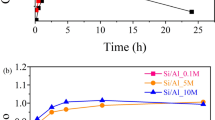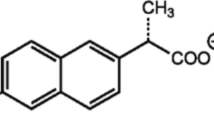Abstract
The interaction between N-methyl 8-hydroxy quinoline methyl sulfate, a drug that absorbs erymathogenic near-ultraviolet radiation, and smectite was studied by X-ray powder diffraction (XRD) and adsorption and desorption techniques. From the adsorption studies, (1) the amount of the drug adsorbed by Na-smectite increased with the pH of the solution to pH 6.5 and then decreased as the pH was further increased; (2) the maximum amount adsorbed at pH 6.5 was 102 meq/100 g of clay; and (3) the maximum amount of drug adsorbed, according to the adsorption isotherms at pH 4, was close to the cation-exchange capacity of the smectite (80 meq/100 g). The XRD studies showed that the drug molecules were adsorbed in the interlayer space of smectite and that cation exchange was the chief mechanism responsible for these interactions. The results of the adsorption-desorption cycles of the drug by smectite showed that this clay is a good support for this compound. In addition, an alternative method was developed to obtain the intercalation compound to avoid the standard method of exchange by impregnation. The method consisted of grinding a mixture of the drug with the clay. The characteristics of the complex thus formed were similar to those of the complex formed by exchange at pH 4 to 7.
To gain insight into the pharmacological properties of the intercalation compound studied, its capacity for absorption of visible and near-ultraviolet light was investigated. The diffuse reflectance spectrum of the complex showed intense absorption bands, absent or weak in the spectra of the pure drug or the untreated clay, at 250, 290, and ~390 nm.
Resumen
Se ha estudiado mediante difracción de rayos X (DRX) y técnicas de adsorción-desorción la interacción entre el metil-sulfato de N-metil 8-hidroxiquinolina, una droga que absorbe las radiaciones erimatógenas de la zona ultravioleta próxima, con la esmectita. A partir de los estudios de adsorción se ha encontrado que: (1) la cantidad de droga adsorbida por la esmectita sódica aumenta con el pH hasta 6.5 y luego disminuye; (2) la máxima cantidad adsorbida a pH 6.5 fue de 102 meq/100 g de arcilla; y (3) la cantidad máxima adsorbida, según los datos de la isoterma medida a pH 4, es similar a la capacidad de cambio de la esmectita (80 meq/100 g). Los estudios de DRX señalan que las moléculas de droga se adsorben en el espacio interlaminar de la esmectita y que el mecanismo principal de la interacción esmectita-droga es el cambio catiónico. Los resultados de los estudios de ciclos de adsorción-desorción señalan que esta arcilla es un buen soporte para este compuesto. Además, se ha desarrollado un método alternativo para obtener compuestos de intercalación que evitan el método convencional de intercambio por impregnación. El método consiste en la molienda de una mezcla de la droga y de la arcilla. Las características del complejo así formado son similares a las del complejo formado por intercambio a pH entre 4 y 7.
Con objeto de profundizar en el conocimiento de las propiedades farmacológicas del compuesto de intercalación estudiado, se ha ivestigado su capacidad de absorción de luz en la zona visible y ultravioleta próxima. El espectro de reflectancia difusa del complejo pretensa intensas bandas de absorción, ausentes o débiles en los espectros de la droga pura o de la arcilla, sola, a 250, 290, y ~390 nm.
Similar content being viewed by others
References
Ainsworth, C. C., Zachara, J. M., and Schmidt, R. L. (1987) Quinoline sorption on Na-montmorillonite: Contributions of the protonated and neutral species: Clays & Clay Minerals 35, 121–128.
Brindley, G. W. and Brown, G. (1980) Crystal Structures of Clay Minerals and their X-ray Identification: Mineralogical Society, London, 495 pp.
Faller, J. W., Mueller, A., and Phillips, J. P. (1964) Mero-cyanines with chelating properties: Talanta 11, 641–646.
Frei, R. W. (1976) Diffuse reflectance spectroscopy; applications, standards, and calibration (with special reference to chromatography): J. Res. Natl. Bur. Stad., Sect. A 80, 551–565.
Frei, R. W., Frodyma, N. N., and Lieu, V. T. (1975) Diffuse reflectance spectroscopy: Compr. Anal. Chem. 4, 263–354.
González-Zapatero, M. (1966) Complejos de adsorción de minérales de la arcilla con fosfato de alquilo: Ph.D. thesis, University of Salamanca, Salamanca, Spain, 212 pp.
Grim, R. E. (1962) Applied Clay Mineralogy: McGraw-Hill, New York, 422 pp.
Grim, R. E. and Güven, N. (1978) Bentonites: Geology, Mineralogy, Properties and Uses: Elsevier, Amsterdam, 256 pp.
Jones, C. E. and Klier, K. (1972) Optical and spectroscopic methods for the study of surfaces: Annu. Rev. Mater. Sci. 2, 1–32.
Kellerman, R. (1979) Spectroscopy in Heterogeneous Catalysis: W. M. Delgass, G. L. Haller, R. Kellerman, and J. H. Lunsford, eds., Academic Press, New York, 86–131.
McGinity, J. W. and Lach, J. L. (1976) In vitro adsorption of various pharmaceuticals to montmorillonite: J. Pharm. Sci. 65, 896–902.
Mortland, M. M. (1970) Clay-organic complexes and interactions: Adv. Agron. 22, 75–117.
Sánchez-Camazano, M., Sánchez-Martin, M. J., Vicente-Hernandez, M. T., and Dominguez-Gil, A. (1987) Adsorp-tion-desorption of Sotalol hydrochloride by Na-montmo-rillonite: Clay Miner. 22, 121–128.
Sánchez-Martín, M. J., Sánchez-Camazano, M., Vicente-Hernández, M. T., and Domínguez-Gil, A. (1981) Interaction of propanolol hydrochloride with montmorillonite: J. Pharm. Pharmacol. 33, 408–410.
Simmons, E. L. (1974) Application of diffuse reflectance spectroscopy to the chemistry of transition metal coordination compounds: Coord. Chem. Rev. 14, 181–196.
Theng, B. K. G. (1974) The Chemistry of Clay-Organic Reactions: Wiley, New York, 221–319.
Vicente, J., Hernández, P., and Hernández, L. (1985) Determination espectrofotométrica de metilsulfato de N-me-til-8-hidroxiquinoleina: An. Real Acad. Farm. (Madrid) 51, 301–308.
Vicente-Hernández, M. T., Sánchez-Camazano, M., Sánchez-Martin, M. J., and Dominguez-Gil, A. (1983) Caracterización de la montmorillonita Albagel: Ciencia Ind. Farm. 2, 335–338.
Author information
Authors and Affiliations
Rights and permissions
About this article
Cite this article
Vicente, M.A., Sánchez-Camazano, M., Sánchez-Martín, M.J. et al. Adsorption and Desorption of N-Methyl 8-Hydroxy Quinoline Methyl Sulfate on Smectite and the Potential Use of The Clay-Organic Product as an Ultraviolet Radiation Collector. Clays Clay Miner. 37, 157–163 (1989). https://doi.org/10.1346/CCMN.1989.0370207
Received:
Accepted:
Published:
Issue Date:
DOI: https://doi.org/10.1346/CCMN.1989.0370207




